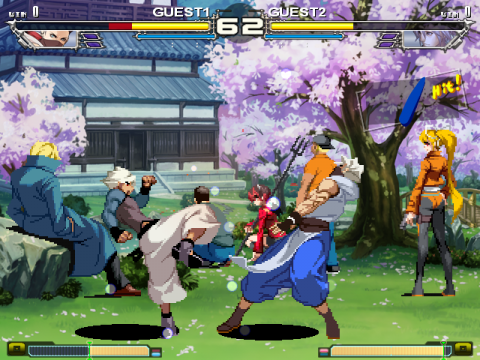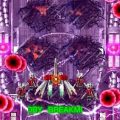Yatagarasu is a doujin fighting game. That alone might be enough to put some people off, but Yatagarasu is different. For one, it is one of the few doujin fighters that abstain from shameless pandering to the moe audience and go for a more “mature” anime style design, not unlike SNK’s The King of Fighters series. This is certainly rooted in part in the game’s pedigree: The graphics are created by Kotani:Tomoyuki, who used to be a sprite artist from KoF ’99 to KoF 2001 under his pseudonym Styleos (more recently, he has done illustrations for a number of Cave shoot-em-ups). Game designer Ume-zono is mostly known as a high level tournament player of Street Fighter III: 3rd Strike, but he also has some King of Fighters credits under his belt, as he has worked as a “planner” on the 2002 iteration.
The basic controls don’t differ much from the classic 2D fighters: Like in The King of Fighters, four buttons are used for quick and strong punches and kicks. Combining the buttons allows for throws, an overhead hopping attack and an unblockable but slow strike, which makes the character turn darker for a moment. All the typical movement options like high jumps, dashes, quick and delayed getups after a fall are also in place. Special moves have enhanced versions activated by pressing both buttons from the same attack type instead of one, similar to Street Fighter IV. Taken from Street Fighter III is the prompt to choose the preferred super move after selecting a character. But here it doesn’t limit the options during the fight, but merely makes the chosen attack more powerful.
Yatagarasu‘s main innovation lies in its parry system, which is also vaguely inspired by 3rd Strike: While regular blocking just requires holding backwards like in any other 2D fighting game, the opponent’s attacks can also be met with “Button Locking” – pressing the matching parry button against either high or low moves just in time not only blocks the attack, but turns the character blue for a moment and warrants a brief time window of advantage over the stunned attacker. There is no animation until the maneuver connects, so the only visual feedback to help learning the timing are two flashing lights below the character’s health bar. It’s very easy to get this wrong, and failure is punished harshly with increased damage for the opponent’s attack.
As usual, there’s no way to escape subsequent blows once caught up in a combo, but it’s possible to slightly reduce the damage dealt with each consecutive hit by pressing the same buttons in synch with the opponent. The timing for this isn’t easy, but at least the player on the receiving end of the beating isn’t forced into the position of a mere spectator for the duration of a combo.
Speaking of spectators, there is one even more peculiar but also really strange feature in the game. After the character selection, players get to choose from various commentators, who then keep babbling during the fight, supposedly reacting to the action dynamically. The well-known speakers may have some pull for the hardcore competitive fighting game audience, but their purpose is lost entirely on non-tournament players. In fact, they can be rather distracting and annoying during play. Fortunately the commentary can be switched off for offline play, at least.
Available playing modes are just the very bare necessities: There’s the obligatory arcade mode with text conversations between the opponents before every match, offline and online versus modes, and a practice mode. The latter at least has a decent range of customization options. It lacks any active tutorials to teach combos or advanced mechanics, but the game tries to keep things simple and more focused on mind games rather than endless combo strings and elaborate cancelling, anyway.
Made by industry professionals or not, Yatagarasu cannot hide the fact that it has been a low budget project with just three guys working in their free time at its core (programmer Shiza completes the PDW/Hotapen trio). When the first version was sold in 2008, the game launched with a measly two playable characters to choose from. Through several upgrades over the years, the cast has gone up to eight, although two fighters are just variations of their respective rivals. The boss is also just a disappointing shadowy version of the main hero, and defeating him is rewarded with nothing more than a few sentences of plain text – in Japanese, of course.
The graphics use a combination of low-res pixel art characters with more hi-res photoshopped backgrounds, evoking SNK’s Atomiswave era. The style of the arenas is a bit inconsistent. Some are kept in a realistic anime style, while others range from traditional Japanese paintings to borderline expressionism. Many of them look a bit trippy, and in a good way, but they are all still paintings with no variations or animations. The characters are animated all the better, despite a few weird frames and some moves that are a bit too reminiscent of The King of Fighters characters. The 4:3 aspect ratio also seems a bit antiquated. Shiza has documented experiments with a wide screen mode, on his blog, but that was never used in the actual game. With this type of game, though, a change in aspect ratio is bound to bring major changes to the dynamics of play, so that might be a reason.
The unused wide screen test mode.
The soundtrack has been commissioned to SamuraiCastle and Ezmen of the doujin composer group Onoyamatakematsu. It starts with an ass-kicking J-Rock title theme sung by Liqu@, which really serves the otherwise pedestrian trailer well to get players pumped for the game. The rest of the music is more subdued and typical fighting game techno fare. Still, some of them are excellent tunes that might find their way onto more than a few MP3 playlists alongside the title theme. There are a few other rock style tracks, which are also composed very well, but the synth instruments used sound a bit weak.
Yatagarasu sure feels polished for a doujin title. The production values are by no means up there with BlazBlue or King of Fighters XIII, but the game makes up for that with its very own charm that is bound to find fans among those that considered the Nests Saga the epitome of KoF character design. That said, it still doesn’t quite feel like a complete package. PDW/Hotapen did their best to try and make the simple approach a virtue, but in the end that means there is not that much to see and explore. Despite the game being not as daunting to get into as some of the overcomplicated “mainstream” fighters, it’s still a fighting game for serious competitive players first and foremost. The demand for high precision and lack of “fluff” causes it to be not very inviting to more casual audiences.
Since Yatagarasu is so comfortably grounded in genre tradition, it’s also hardly a game anyone just “needs” to play. It’s still a blast for a few matches, but it might not last very long. The seeds for something great are definitely there, though. Especially promising is the yet underdeveloped setting in an alternate history 1926 Japan, with ninja clans waging war in the country’s early modernity. Unfortunately the storyline remains underdeveloped and is limited to a bit of dialog text in arcade mode.
During summer 2013, the Yatagarasu team ran a successful crowdfunding campaign. The project: an upgrade with the slightly nonsensical byname Attack on Cataclysm. Finished two years later, this version is still very close to the original game, with many little tweaks but no new major elements. The bulk of the development work was put into three entirely new characters, which fill out a few corners in the roster. Yatagarasu: Attack on Cataclysm also came fully localized for the first time, even adding canned commentators from the UK tournament scene (James Chen, David Philip Graham and Maximilian). In Japan the game was also distributed in arcades with the help of Taito, in hopes to push the game into the tournament spotlight.
In 2012, Nicalis had announced to port the original game to the 3DS, but after news had been very slow for about a year, it was scrapped in favor of a PSVita version. This was originally slated for a 2013 release as Legend of Raven, but so far nothing has come out of it. And since it is based on the earlier PC version 4.3 with only 8 playable characters, it’s already outdated before it even comes out (if it is ever released at all).
Links:
PDW/Hotapen Japanese Homepage.
Yatagarasu FTG English Community Hub.
Rice Digital Store Page of the English distributor.
Legend of Raven Nicalis’ English homepage for the PSVita version.
Rice Digital Interview A few words from the developers.
Onoyamatakematsu Homepage of the soundtrack composers.


